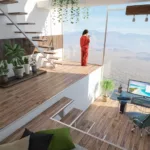Stefan Engel, VP & GM Visuals Business for Lenovo, published a paper on the future of monitors that suggests a substantial change is coming to how we visually interface with our computers. Lenovo appears to be setting up to disrupt the monitor space, and Engel’s paper highlights some interesting concepts for the future. Lenovo is already leading its peers with foldable, and head-mounted displays, but these changes are just the beginning. As we approach the end of 2021, let us look at what will be coming with the next generation of monitors from Lenovo and others.
Using Stefen’s predictions as a baseline, let us talk about what is coming in monitors in the next few years.
What is driving the change
Clearly, a big part of the coming changes has to do with how we are now working due to both the pandemic and the massive talent shortage plaguing the industry. Monitors will have to adapt to the reality that many workers may never make it into an office and will instead have to address the unique design and usability needs of people working from home.
Monitors not only will be plugged into PCs, but some will also need to work with gaming systems and smartphones as Engels points out in his paper. Monitor clutter will need to be addressed by reducing wiring and building in things like speakers and cameras to lessen complexity. But they will also have to be optimized for remote meetings and increasingly anticipate the need for cloud-connected applications that may need to work even if a smartphone or PC is not connected to the monitor.
What is coming
This all means that the coming monitors will be thinner to make them more attractive, some will have wireless connectivity to reduce the cluster of wiring, and some will have enhanced capabilities as dedicated video conferencing monitors that can double as an extended monitor when needed. Engels argues that this will result in more modular designs that should keep entry-level prices down but allow for users who want to enhance their monitor as needed by paying for those enhancements themselves since it is unlikely that IT will fund some of the more entertainment-focused capabilities.
One change that Engels does not really touch on but that is being worked on is embedding the video camera into the screen. With that design change, the camera is more centrally placed and does not angle down on the user. Lenovo and others are working on technology that adjusts the image to make it appear as if you are always looking into the camera, even if your eyes are wandering.
For some time, Lenovo has worked to make monitors more attractive and efficient but, as Engels points out, all that development will become reality next year. This suggests that the next generation of monitors will sport more attractive designs and materials to better fit in with home decor. Monitor builders have experimented with natural finishes in the past like walnut, but metal finishes continue to be the favorite and, I expect, we will see a greater mix of these finishes as options so you can both configure a monitor for usage features as well as something that blends into your home design theme.
Lenovo and others focus on making all technology more sustainable which should both help drive the modular and natural finish efforts to reduce the amount of waste that this component produces. One coming alternative that Lenovo is on top of is head-mounted displays which could change the entire dynamic in this space, but it will take a few years yet for that technology to mature.
Wrapping up:
We are going through a huge phase of reconsidering the hardware we provide employees who are now largely working from home and may never return to the office. Thus, design considerations for existing products that were based on reduced need to go into the office will be giving way to design considerations for home and increased remote use. This means designs will be focused on looking good in the home and have the flexibility to mesh with the variety of hardware in people’s homes, including game machines and smartphones. In addition, this will drive modular designs and more sustainable materials both of which potentially address the increasing requirement that technology reflects the desire for a more sustainable future.
Modifications for video conferencing and cloud connectivity coupled with wireless connections will provide reduced clutter and increased functionality as these monitors increasingly anticipate a cloud-connected personal technology future. Part of this change will be an increasing focus on head-mounted displays, something that Lenovo is focusing hard on. Not all of this will arrive in 2022, but these changes should be in full swing by 2025. Anticipating these trends should help you pick products that are more forward-looking and less likely to become prematurely obsolete. Changes are coming to the monitor space, and Lenovo plans to help drive these changes. In the end, the home office of tomorrow will look nothing like the home office of today.








